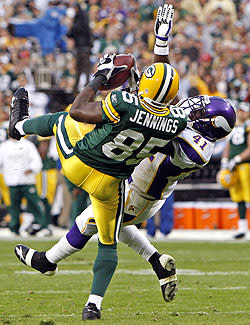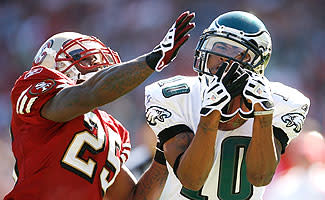Small receivers coming up big
GREEN BAY, Wis. – Greg Jennings didn't particularly like how the measurement rolled off a visitor's tongue. It reached down and squeezed a nerve that had been strangling his football career for too long.
Five-foot-11? Jennings made a bitter face when he heard the number.
"I'm six-feet tall, man," he said with a chill in his voice. "Six feet."
His incredulous stare might have ended the conversation right there, had it not been for Jennings' Green Bay Packers teammate, Donald Driver, who stepped out of the shower and into the fray. Peeking from under a towel, Driver snickered and taunted: "He ain't six feet. Don't let him tell you that. No way."
Jennings would relent, but not without a fight. Being pigeon-holed in the NFL as a 5-foot-something wide receiver is a little like being a trapeze artist with short arms. At least that was the stereotype before this season, which has seen diminutive receivers jump out to their strongest start in league history.

Jennings comes down with a tough catch in the opener.
(AP Photo/Mike Roemer)
Thanks to passing offenses that are providing greater opportunity, six wideouts under 6-feet are on pace to break 1,000 receiving yards this season – Jennings, Santana Moss of the Washington Redskins, the Buffalo Bills' Lee Evans, Steve Smith of the Carolina Panthers, the Philadelphia Eagles' DeSean Jackson and Wes Welker of the New England Patriots. Two others (the New Orleans Saints' Devery Henderson and the New York Jets' Laveranues Coles) are on pace to break 950. If all eight were to top 1,000 receiving yards, it would be the first time in NFL history that so many players under six feet had gone over the mark.
That's saying something in a league that has seen healthy cycles of small wideouts in the past, from the explosiveness of Gary Clark to the Redskins' "Smurfs" to a litany of mighty mites that passed through Run and Shoot offenses in the 1980s and 1990s. But it wasn't until now that the small receiver has experienced such an impactful revolution. As it stands, four of the top seven wideouts in receiving yardage are under six-feet tall. And four of the top five players in average yards per catch also hold that distinction.
Part of the spike can be attributed to a haul of talented smaller receivers coming out of college in the last decade. And part of it can be attributed to offenses that are incorporating those players in more creative ways.
"Way back, let's say 20-25 years ago, the West Coast system rarely used anything but two wideouts, a tight end and two backs on first and second down," said Eagles offensive coordinator Marty Mornhinweg. "And then you'd have the three or four wides on third down. Well, that third-down offense has become the first-, second- and third-down offense in this league. You'll see three and four receivers, one running back, and in many cases, four or five receivers with no back – or if you've got a capable back, you're splitting him out. The game has changed that way a little bit so that the smaller stature players have a place."
Compact packages
Ideally, teams would like every small receiver to be built like Smith or Moss – strong, compact, fluid and tough enough to take a jam from a "hard" cornerback in a Cover 2 defense. Excluding physical freaks like Andre Johnson and Calvin Johnson, most small receivers have a few distinct advantages over their "prototype" counterparts: quickness, change of direction and acceleration to top speed. All three of those things can help provide the separation that truly matters in successful passing offenses.
"They're more explosive coming out of their routes because of their body types," said Redskins offensive coordinator Sherman Smith, who starts a pair of 5-10 receivers in Moss and Antwaan Randle El. "Deion Sanders was talking about it the other day, about guarding a bigger wide receiver and how they are slower out of their breaks than a smaller wide receiver."
"Regardless of how fast you are, you probably will get to your top speed quicker than a 6-foot-3 guy," said Jennings. "You're going to put that stress on a defensive back quicker than a 6-foot-3 guy would."
Mornhinweg and Sherman Smith point to that advantage forcing teams to be more open-minded about smaller, quicker players. As part of the league's cyclical nature, larger, more physical cornerbacks were drafted to counteract larger receivers. Now many teams are looking for at least one smaller, quicker and more precise route runner to give them the opportunity to game plan matchup problems. But that matchup isn't necessarily the slot anymore. Like Clark before them, undersized receivers are now showing they can thrive as primary targets.
"I hope it breaks some stereotypes," said Jennings, who is second in the NFL with 685 receiving yards. "A lot of us are out there playing with that chip on our shoulders. A lot of us are saying, 'I can go up and get the deep ball. I can go up and get the fade route. I can make any catch a 6-5 guy can, and then I can give you something after the catch.' "
Jennings says it as if he's channeling Rod Tidwell, the infamous undersized wide receiver sparked with attitude in the movie "Jerry McGuire." Indeed, you'd be hard pressed to find a smallish wideout in the NFL who doesn't identify with Tidwell, a fictional character who despite his production was labeled a "shrimp" by his coach.
Not measuring up
In their own way, all of the NFL's smaller receivers have suffered that "shrimp" label like a sliver in the brain. From Carolina's Smith, who fell to the third round of the 2001 NFL draft despite being a highlight machine at Utah, to Jackson, who saw a similar slide this past April despite being one of college football's most explosive offensive weapons.
"The wide receiver coach with the Eagles has told me 'If you had a couple more inches on you and weighed about 185, I guarantee you would have been a top five or top 10 pick,' " Jackson said. "(Size) definitely didn't help me. … When I went to the combine, they made a big deal out of every little centimeter and every single pound. I went in at 169 pounds and they wouldn't round it off to 170. I was like 5-9¼ and they wouldn't even give me 5-10."

Jackson leads the Eagles in catches and receiving yards.
(Getty Images/Greg Trott)
Now Jackson and the St. Louis Rams' Donnie Avery (5-foot-11) are claiming their places as two of the most explosive rookies in the game. Jackson's 505 yards lead all first year wideouts, while Avery has put up 291 and two touchdowns over the last three weeks – against Washington, Dallas and New England. But they aren't just linked by their stature and production. Coming out of the University of Houston, Avery found himself pulling out every stop leading into the draft, hoping to get teams to ignore his lack of size.
"I was trying to sell myself," Avery said. "By the end of it, I was telling teams, 'You know I'm not just a receiver, I'm a return specialist as well, and I play all the special teams. I can be a gunner on punts and everything.' "
But even with their impressive workouts, gaudy college stats and supreme sales jobs, Avery and Jackson fell out of the first round of the draft. It's a familiar tale. The best small wide receivers in the NFL rarely come from first-round stock, largely because teams refuse to risk prime draft choices on short commodities. In fact, of the 41 wide receivers selected in the first round of the last 10 drafts, only eight have been under six feet tall.
"It's easy to get caught up in trends, where we don't take a guy unless he's 6-1," Packers coach Mike McCarthy said. "… When a name goes up on the board, if it's 5-10 and 190 pounds, you've got to look at his body type. There are all kinds of body types. The bottom line is they have to be able to separate from the defender."
Despite the historical knocks, small receivers are proving they can do just that. Whether it's Jennings and Henderson, who lead the league with five catches apiece of 40-plus yards, or Evans and Jackson who have totaled 21 receptions of more than 20 yards, the stature of their games has outgrown the size of their bodies.
Maybe Jackson said it best this week, while reflecting on the NFL teams that passed him over because of his size.
"There are a lot of people," he said, "eating their words right now."